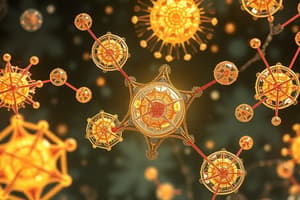Podcast
Questions and Answers
What is the state of matter where atoms are tightly packed together due to strong forces between them?
What is the state of matter where atoms are tightly packed together due to strong forces between them?
- Solid (correct)
- Liquid
- Gas
- Plasma
Which of the following is NOT one of the four main states of matter encountered in everyday life?
Which of the following is NOT one of the four main states of matter encountered in everyday life?
- Solid
- Gas
- Liquid
- Plasma (correct)
In the solid state, what prevents atoms from moving away from their fixed positions?
In the solid state, what prevents atoms from moving away from their fixed positions?
- High kinetic energy
- Weak intermolecular forces
- Lack of electrons
- Strong forces between atoms (correct)
What exotic state of matter is formed at extremely low temperatures close to absolute zero?
What exotic state of matter is formed at extremely low temperatures close to absolute zero?
Which subatomic particle determines the element that an atom represents?
Which subatomic particle determines the element that an atom represents?
What is the primary factor that distinguishes gases from liquids?
What is the primary factor that distinguishes gases from liquids?
Which statement accurately describes plasma in comparison to gases?
Which statement accurately describes plasma in comparison to gases?
Under what conditions does Bose-Einstein Condensate occur?
Under what conditions does Bose-Einstein Condensate occur?
What defines the behavior of a Fermi gas at almost absolute zero?
What defines the behavior of a Fermi gas at almost absolute zero?
In Debye solids, what restricts the movement of ions at low temperatures?
In Debye solids, what restricts the movement of ions at low temperatures?
Flashcards are hidden until you start studying
Study Notes
Atoms and Molecules - A Deeper Look into States of Matter
Atoms and molecules form the fundamental building blocks of all matter around us. They are incredibly tiny particles that make up everything we can see and touch. Understanding their behavior and interactions is essential for understanding the world around us. This article aims to explore atoms and molecules by delving into their properties and behaviors in different states of matter.
Atomic Structure
Before we dive into the states of matter, let's first understand what an atom looks like. An atom consists of a small, dense nucleus surrounded by a cloud of electrons. The nucleus contains protons and neutrons, which give the atom its mass and electrical charge. Electrons orbit the nucleus in shells, with each electron occupying a specific orbital path. The number of protons in the nucleus determines the element—for example, hydrogen has one proton, helium two, oxygen six, etc.
State of Matter
Now, let's move on to states of matter. In everyday life, we encounter four main states: solid, liquid, gas, and plasma. However, there are three more exotic states: Bose-Einstein condensate, Fermi gas, and Debye solids. Let's examine these states in detail:
Solid State
In the solid state, atoms are tightly packed together due to strong forces between them. These forces prevent the atoms from moving away from their fixed positions. Examples of solids include metals, rocks, diamonds, and ice.
Liquid State
When heat is applied to a solid, it melts into a liquid. Here, atoms or molecules are less densely packed, allowing some freedom of movement. However, they still remain relatively close to each other. Since they don't have enough energy, they cannot overcome the force holding them together. Common examples of liquids are water, oil, and mercury.
Gas State
A further increase in temperature converts the substance into a gas. Gases are highly dispersed, meaning the distance between individual atoms or molecules becomes very large. There is now plenty of space between the particles, resulting in low density. Gases expand to fill any container they are placed in because their particles are constantly moving and colliding with each other.
Plasma State
Plasmas are extremely hot gases where most electrons become free and move independently. As a result, plasmas can conduct electricity much better than normal gases. Several stars, including our Sun, are made mostly of plasma. It's also found in neon signs, fluorescent light bulbs, lightning, and even inside nuclear fusion reactors.
Other Exotic States
The above states cover most materials we encounter in daily life. However, under extreme conditions, other states may exist:
-
Bose-Einstein Condensate: This occurs when atoms cool down so much that they lose nearly all of their kinetic energy. Eventually, they pile up in the lowest possible quantum state, behaving collectively rather than individually. This state is only observed in super-cold environments.
-
Fermi Gas: When you cool a material to almost absolute zero (-273°C), some atomic nuclei, such as iron and uranium, collapse inward, creating high pressure within the tiny volume left. These nuclei behave almost like a fluid, called a Fermi gas, which flows slowly through the surrounding atoms.
-
Debye Solids: At low temperatures, some insulators change phase into a state where the movement of ions is restricted to vibrating within a lattice structure without changing their relative position in the crystal. This type of solid is known as a Debye solid.
Conclusion
Understanding how atoms and molecules interact in various conditions sheds light on the fascinating world of chemistry and physics. From the cohesion of solids to the flow of gasses, every part of nature can be traced back to changes in the arrangement of atoms and molecules.
Studying That Suits You
Use AI to generate personalized quizzes and flashcards to suit your learning preferences.




